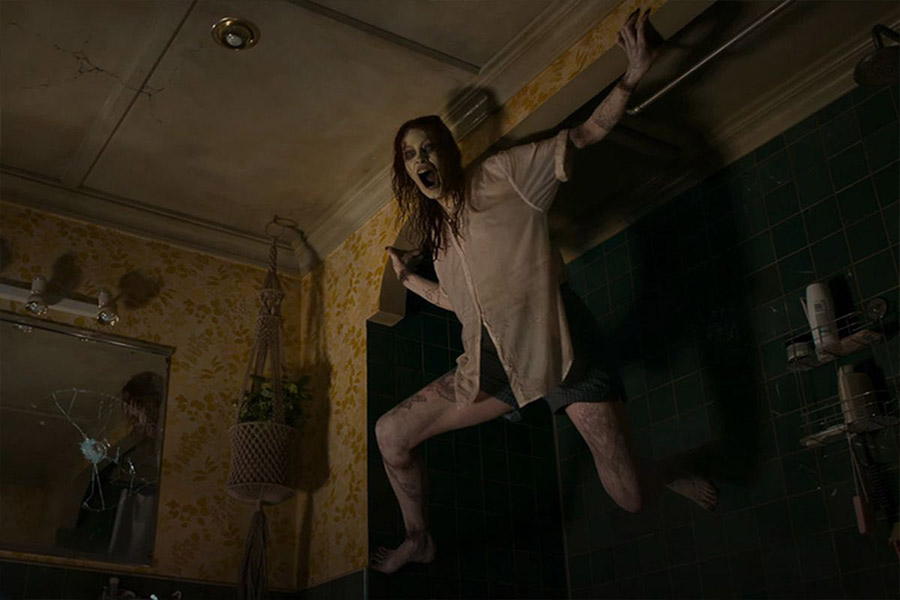Directed by Irish filmmaker Lee Cronin, Evil Dead Rise keeps alive the ‘book of evil’ mythos of the Evil Dead film series and presents a sleek reboot of Sam Raimi’s original low-budget cult horror film. Staying true to the franchise’s supernatural-cum-slasher theme, Evil Dead Rise follows a family as it tries to escape the deadites’ ‘dead by dawn’ prophecy and turns into a horror fan’s delight. Here’s why.
Supernatural horror rips a family apart
Like in his last film The Hole in the Ground, Cronin, who also wrote the script for Evil Dead Rise, concentrates on the family in his first outing in the Evil Dead franchise. There’s Beth (Lily Sullivan), her sister Ellie (Alyssa Sutherland) and Ellie’s three children. A guitar technician, Beth decides to take a break from life on the road after discovering she’s pregnant and visit her sister’s family who live in a decaying apartment building in Los Angeles. Ellie, on the other hand, is dealing with her recent separation from her husband.
The family tensions take a back seat when a sudden earthquake leads Ellie’s music-enthusiast son Danny (Morgan Davies) to discover a cursed book and some vinyl records in their basement parking lot. Despite objections from his sister Bridget (Gabrielle Echols), an unsuspecting Danny plays the records and opens the book with eagerness, ending up resurrecting an evil spirit that sparks off a violent struggle for survival among the family members.
The bone-chilling opening sequence sets the tone
Evil Dead Rise begins with a ‘cold open’, where the narrative launches right into the story even before the opening credits are shown. We see three characters at a lakeside cabin — a young woman who is vacationing with her boyfriend and cousin sister. The young woman has been feeling sick and soon turns into a demonic creature, decapitating her boyfriend and rising from the lake as the titular Evil Dead.
Aided by an eerie background score, this startling opening sequence sets the tone of the film, assuring horror fans that a thrilling gore fest will follow in Sam Raimi’s Evil Dead tradition. Before rewinding a day earlier to the condemned Los Angeles apartment building, where the main action unfolds, this makes for one of the most memorable title card sequences in recent horror film history.
Sister-vs-sister survival thriller
Creating believable constraints in a plot in the survival horror sub-genre can be quite tricky. In Evil Dead Rise, a strong earthquake in Los Angeles shatters parts of an old apartment building that had already been designated for demolition. Nine residents are trapped in the building with the stairs gone and the fire exit jammed. And since using elevators after an earthquake is not advisable, the premise is set for a fight-for-survival thriller, only here the deadites (the evil dead) arrive unmistakably to claim the living.
Ellie is in the building’s elevator, and a demonic spirit takes control of her body to kill all her children and unite their bodies as one. As Ellie attacks her own brood, her estranged sister Beth tries to whisk the children away from their undead mother while grappling with her own pregnancy. The themes of motherhood, abandonment and the love-hate relationship between siblings play out against the backdrop of the supernatural horror that increasingly gets intense.
The foreboding makes every moment worth it
What makes Evil Dead Rise so effective is its brilliant staging of horrific events and the foreboding. The element of thrill and fear doesn’t only come from the frequent jump scares but also with the anticipation of ominous events. When we first meet the family, the youngest one Kassie (Nell Fisher) is seen decapitating a doll with scissors and mounting it on a stick. In a commotion with her elder sister Bridget, the stick snaps into two and she chases Bridget with the pointy end of the stick. The traditional horror trope suggests this scene will end up anything but rosy, the bond between these two little sisters does look like a poster of sibling camaraderie. Although, all these props and tropes ultimately lead to a dreadful end. The climactic scene also gives a timely and adequate nod to the ‘chainsaw’, which was made famous by Raimi’s first film in the franchise — Evil Dead — in 1981.










